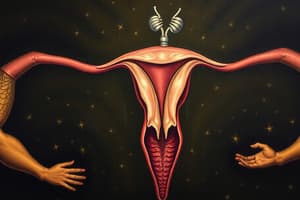Podcast
Questions and Answers
What is the process that involves the fusion of sperm and egg cells?
What is the process that involves the fusion of sperm and egg cells?
- Fertilization (correct)
- Parthenogenesis
- Meiosis
- Budding
Which type of reproduction involves the development of offspring from a single parent organism?
Which type of reproduction involves the development of offspring from a single parent organism?
- Fertilization
- Meiosis
- Binary fission (correct)
- Fragmentation
In animals, which gametes are produced in the female reproductive system?
In animals, which gametes are produced in the female reproductive system?
- Eggs (correct)
- Sperm
- Zygotes
- Embryos
Which biological process involves the formation of gametes?
Which biological process involves the formation of gametes?
What type of reproduction ensures the continuation of species by producing new individuals from existing organisms?
What type of reproduction ensures the continuation of species by producing new individuals from existing organisms?
What is a key advantage of asexual reproduction mentioned in the text?
What is a key advantage of asexual reproduction mentioned in the text?
Which type of parthenogenesis involves females producing offspring without males?
Which type of parthenogenesis involves females producing offspring without males?
What is the key characteristic of sexual reproduction that ensures genetic uniqueness?
What is the key characteristic of sexual reproduction that ensures genetic uniqueness?
Where does fertilization occur externally in some species?
Where does fertilization occur externally in some species?
Why is sexual reproduction assumed to confer advantages over asexual reproduction?
Why is sexual reproduction assumed to confer advantages over asexual reproduction?
Flashcards are hidden until you start studying
Study Notes
Biology Reproduction: A Comprehensive Overview
Biology reproduction is a fundamental process in the life cycle of all living organisms. It involves the production of new individuals from existing ones to ensure the continuation of species. Reproduction can be classified into two major categories: asexual and sexual, each with its unique characteristics and implications for the offspring.
Developmental Biology
Developmental biology is the study of the processes by which organisms grow and develop from a single cell to a complex adult form. It encompasses various aspects of reproduction, including the formation of gametes, fertilization, and the development of the embryo into an adult organism.
Reproductive Systems
Reproductive systems play a crucial role in the transmission of genetic material from one generation to the next. In animals, two types of gametes are produced: sperm (in males) and eggs (in females). These gametes are produced through the process of meiosis, which halves the number of chromosomes in the cell. The fusion of sperm and egg cells results in a diploid zygote, the first cell of a new organism.
Asexual Reproduction
Asexual reproduction occurs when offspring develop from a single parent organism without the involvement of gametes. There are several types of asexual reproduction, such as binary fission, budding, fragmentation, and parthenogenesis. Asexual reproduction is more common in bacteria, some plants, and fungi, but it also occurs in invertebrates, as well as in some fish, amphibians, and reptiles. Asexual reproduction provides some advantages, such as fast reproduction and the absence of genetic variation, but it also has limitations, such as a limited capacity for adapting to new environments.
Parthenogenesis
Parthenogenesis is a form of asexual reproduction in which an embryo develops from an unfertilized cell. There are two main types of parthenogenesis: thelytoky and arrhenotoky. Thelytoky involves thelys, or females, producing offspring without the involvement of males, while arrhenotoky involves males producing offspring through parthenogenesis.
Sexual Reproduction
Sexual reproduction involves the union of gametes from two different individuals, leading to the formation of a zygote. This process ensures that each offspring is genetically unique, which is essential for the survival and adaptation of the species. Sexual reproduction is more common in animals, including all vertebrates, and is assumed to confer advantages over asexual reproduction [1-10].
Fertilization
Fertilization is the process by which sperm cells fuse with an egg cell to form a zygote. Fertilization can occur internally (within the female's body) or externally (outside the female's body). The location and mechanisms of fertilization vary across different species.
In conclusion, biology reproduction is a complex process that involves various mechanisms and strategies to ensure the continuation of species. Both asexual and sexual reproduction have their advantages and limitations, and the choice between these two modes of reproduction is influenced by various factors, including the biology of the species and the selective pressures acting on their populations.
Studying That Suits You
Use AI to generate personalized quizzes and flashcards to suit your learning preferences.




